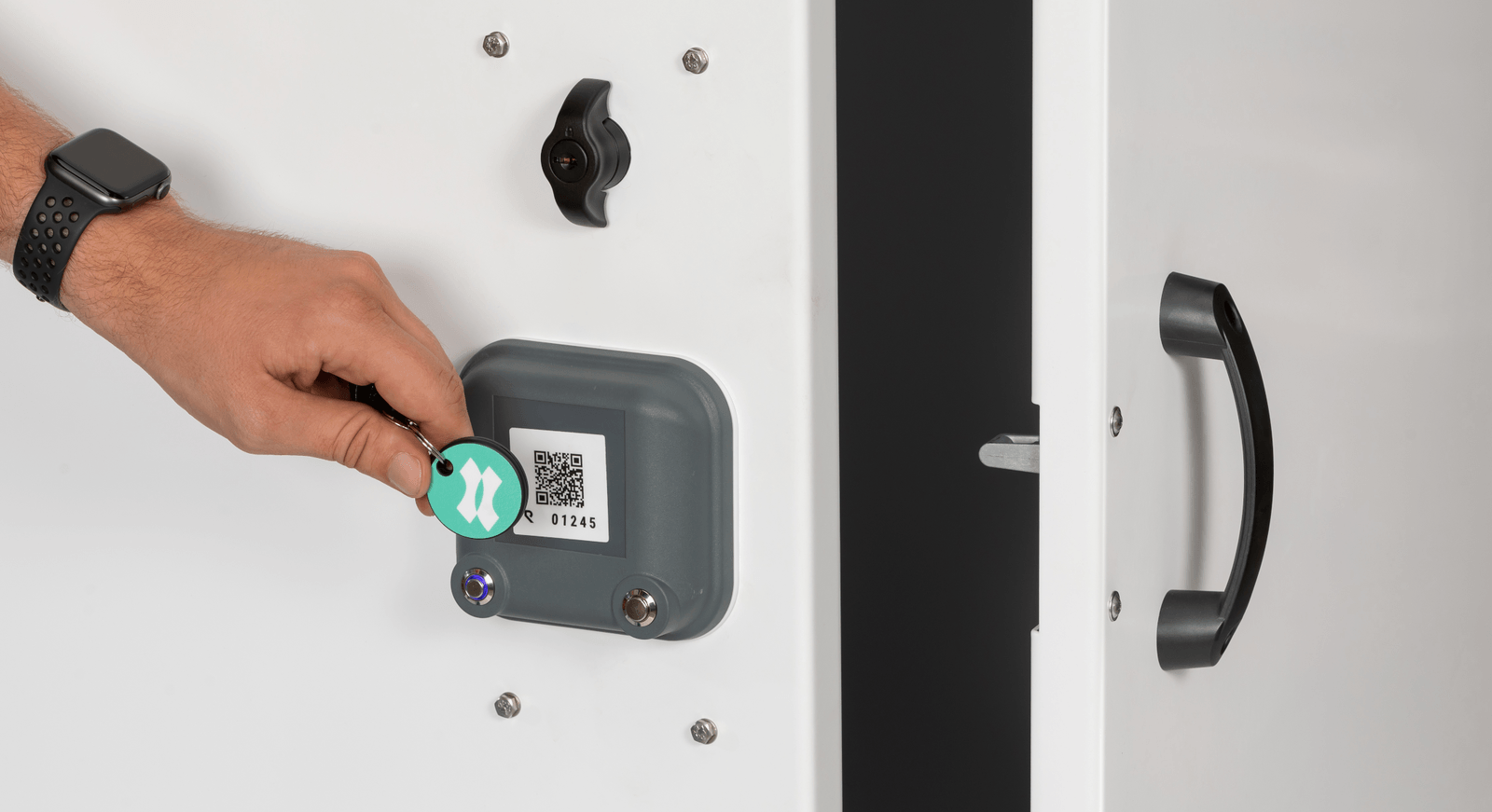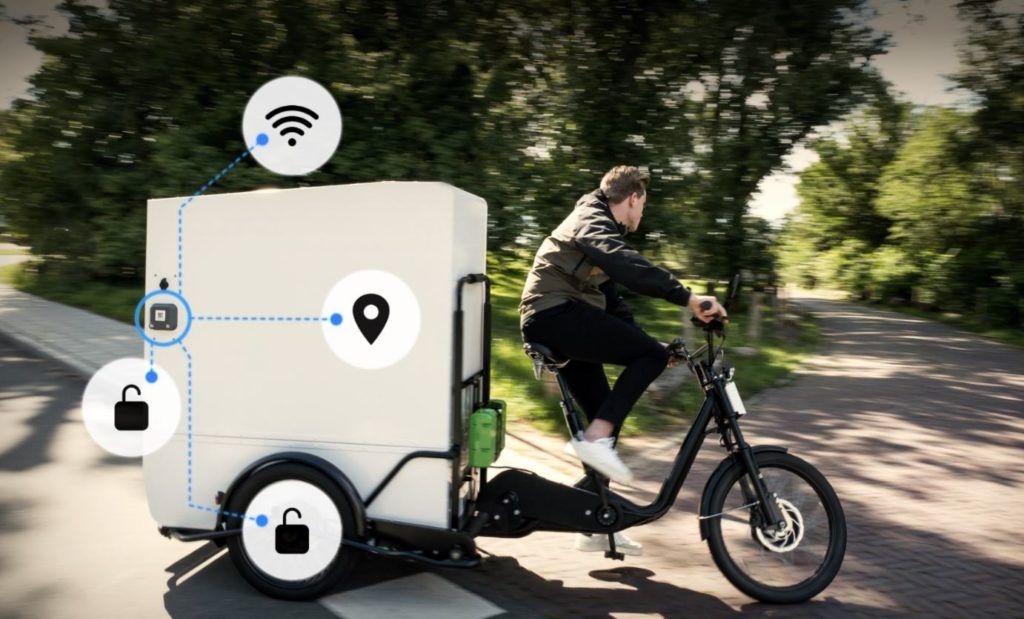
Paztir IoT product brings fleet management and security to the cargo world
A team of economists, cloud specialists, designers and engineers from Paztir are tapping into the now bustling trade surrounding cargo bike fleet management with a steadily developing IoT product that enables fleet managers to reliably, safely and efficiently deploy the cargo bike in place of the van.
Looking from the outside inwards on the cycling industry, the Dutch business has developed software to be integrated into partner derived hardware that will offer a wide range of benefits to cargo bike owners, in particular those managing a fleet. The Internet of Things (IoT) development works to deliver bike security, access management, efficiency in parking and delivery, incident recording, route-planning, route-tracing, and plenty more.
 Paztir's Founders (left to right): Jurij Čelešnik, Nerina Čorbadžić, Andrej Sobotkiewicz, Jure Vižintin and Jure Koren.
Paztir's Founders (left to right): Jurij Čelešnik, Nerina Čorbadžić, Andrej Sobotkiewicz, Jure Vižintin and Jure Koren.
Photo courtesy Rayhaan Imam
A relatively new company at only four years old, the business is addressing a modern problem; how to use modern technology to maintain a competitive edge, save time and money.
Andrej Sobotkiewicz, Chief Executive Officer explains: “We are developing, producing, and selling access management track and trace and smart locking solutions for professionals. With cities closing down for cars, all logistics operators are already implementing cargo bikes and other light electric vehicles (LEVs) to bring parcels to the customers. Even though some countries have known cargo bikes for some years already, having used them to bring produce from farms to markets, they have rarely been used in such a competitive environment as they are now."
"Profits in logistics operations are narrowly bound to the optimization of processes."
"The last-mile delivery is the biggest cost for logistics operators. It is often more expensive to bring the parcels from a city depo to the customer, than to ship them from China to Europe. We are helping to bring these costs down.”
Photo Cargo Cycling
Paztir’s customers generally already utilise an app to manage deliveries, but tracking drivers is not the same as tracking the vehicles, and once the fleet is of a certain size, fleet management, maintenance planning and data capture can become a challenge. For fleet managers, understanding how much each vehicle has driven, what the battery state is, or which event on the field caused the frame to break can be very important information for vehicle maintenance planning.
The tracker is as accurate as they come, measuring to within five to ten metres under most conditions and capturing data every five seconds.
Security too can become a significant head scratcher the more bikes are added, in particular if you have a large fleet with lots of keys, says Paztir Chief Marketing Officer Nerina Čorbadžić.
“Electric cargo-bikes are high value assets, and the frequent scenario of drivers not locking their cargo-bikes and containers is frustrating and risky. The reason why some drivers don’t lock is that using mechanical locks or clicking trough a mobile app to lock and unlock a vehicle takes away valuable time they could spend delivering,” she says.
“We solve this issue by giving drivers a much faster locking experience and giving fleet managers overview over locking activities."
"With Paztir drivers are much more likely to lock the vehicle if all they need to do is push a button, and fleet managers have control over their high value assets."
"They can track if the vehicle is locked, track its location, know if someone is trying to steal it, use logs to track responsibility and deal with insurance. Also, in situations where it would help security, fleet managers can even remotely lock their vehicles.”
While perhaps better suited to OEM partners thanks to integration maximising the system’s potential, Paztir’s product has always been retrofittable with two enclosures with the IoT device installed on the cargo bike’s container.
 Paztir's IoT technology integrated into Cargo Cycling's Chariot
Paztir's IoT technology integrated into Cargo Cycling's Chariot
Photo Cargo Cycling
For the bike maker a collaborative approach exists whereby Paztir and the vehicle producer tailor the ideal way to integrate the technology into the vehicle, from electronics, cabling, power source, to smart locks and electronics enclosure. If all the components and their positions are defined it’s easy to install them in the production assembly, we’re told.
Sobotkiewicz says: “There are several layers of added value for the OEM. Most of our competitors are focusing on track and trace information, upon which the OEMs can build additional services. Normally they would build an app, where they represent information about routes, speed, calories burned, etc. At Paztir we see this as a starting point but go further with access management. This means that the owner of the vehicle has full control over who can access their assets, no matter where they are located.
“This allows them to build-up new business models, especially in the MaaS industry, for the leasing companies. It also empowers the reduction of costs by increasing the safety and security of the assets and more efficient maintenance management. One of the frequent problems of our MaaS customers is that vehicles that should be serviced on a specific day are not in the warehouse, but on the field."
"With our system, you can put a vehicle into maintenance mode, and only the eligible maintenance partner will have access to the vehicle, so no driver can take it out that day.”
So, what does it all cost?
That’s very much an open-ended question and down to the quantity, level of tech needed and whether anything bespoke, such as enclosures are required in the build.
“In general, the biggest difference between OEM and aftermarket costs lies in the installation costs of the system, not so much in the components itself,” says Paztir.
 Integration of Paztir's IoT technology into Ebike4Delivery Gen3 Ebikes
Integration of Paztir's IoT technology into Ebike4Delivery Gen3 Ebikes
Photo: Paztir
The software is offered as a web service which makes it available on all devices that can run on all modern web browsers. It can also be hosted on customer’s domains with their logo and colour palette to maintain their brand identity.
Jure Vižintin, the firm’s Chief Product Officer concludes by summarising where he sees the product fitting into the modern world:
“The Paztir software platform is built to serve the light delivery vehicle market from end to end."
“Producers use it to set up their product – a smart vehicle with smart locks – which is then often sold to a service operator who rents it out to customers. The service operator uses the software to organise, monitor and control the use of the vehicles and to plan maintenance.
“Food or parcel deliveries use the software to track the movement of their vehicles and to manage access for their employees and clients. Their employees can use the software to make vehicle reservations and access the vehicles and cargo with their mobile devices.”